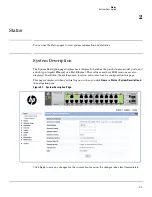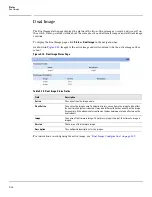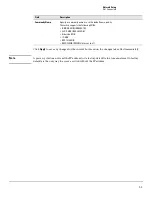
2-13
Status
Spanning Tree
Root Path Cost
The sum of the Port Path costs on the least cost path to the Root bridge. For the Root bridge this is
zero.
Root Port
The port on the switch that forwards traffic toward the Spanning Tree root.
Topology Change
Count
Number of topology changes since STP was enabled.
Time Since Last
Change
Time since last topology change was detected.
Spanning Tree Interface Status
Root Guarded
Interfaces
Interfaces with the Root Guard parameter currently set.
TCN Guarded
Interfaces
Interfaces with the TCN Guard parameter currently set.
BPDU Protected
Interfaces
Interfaces with the BPDU Guard parameter currently set.
BPDU Filtered
Interfaces
Interfaces with the BPDU FIlter parameter currently set.
Interface
The port number.
Interface ID
The priority and port index used by the Spanning Tree protocol.
Role
The current Spanning Tree port role. The port role can be one of the following values:
•
RootPort—
A forwarding port that is the best port from non-root bridge to Root bridge.
•
DesignatedPort—
Each LAN segment has one designated port, a single bridge port to which
packets destined toward the Root bridge are sent.
•
AlternatePort—
When the Designated port is currently on a different bridge, the Alternate Port
is a port on this bridge that may become the Designated port if needed.
•
BackupPort—
When the Designated port is currently a different port on this bridge, the Backup
port is a port on this bridge that can become the Designated port if needed.
•
DisabledPort—
Not strictly part of the Spanning Tree protocol; a network administrator can
manually disable the port.
State
The current Spanning Tree port state. The port state can be one of the following values:
•
Blocking—
A port that may cause a switching loop, no user data is sent or received but it may
go into forwarding mode if the other links in use were to fail and the spanning tree algorithm
determines the port may transition to the forwarding state. BPDU data is still received in blocking
state.
•
Forwarding—
A port receiving and sending data. STP still monitors incoming BPDUs that may
indicate it should return to the blocking state to prevent a loop.
•
Disabled—
Not strictly part of STP, a network administrator can manually disable a port.
Cost
The current Spanning Tree port path cost. This value is either computed from the Auto setting or
from any explicitly configured value.
Hello Time
Hello time parameter currently in use on the port
Point-to-Point
A yes/no value. Yes indicates a switched link with only two nodes. No indicates a shared network
segment with more than two nodes. The value may be automatically computed or explicitly
configured.
Edge
A yes/no value. Yes means there are no bridges attached to this port. No means there are, or might
be, bridges attached. The value may be automatically computed or explicitly configured. If the value
is Yes, the port transitions directly to the Forwarding Port state when Spanning Tree is enabled.
Field
Description
Summary of Contents for PS1810 SERIES
Page 1: ...HP PS1810 Switches Management and Configuration Guide ...
Page 2: ......
Page 3: ...i HP PS1810 Switches Management and Configuration Guide June 2013 ...
Page 10: ...viii ...
Page 34: ...2 18 Status Clock ...
Page 54: ...4 12 Switching Spanning Tree ...
Page 60: ...5 6 Security Secure Connection ...
Page 70: ...7 6 Virtual LAN Advanced Configuration ...
Page 76: ...8 6 Link Layer Discovery Protocol LLDP Energy Efficient Ethernet ...
Page 82: ...9 6 Diagnostics Locator ...
Page 98: ...11 6 Servers Monitor Servers ...
Page 99: ......
















































